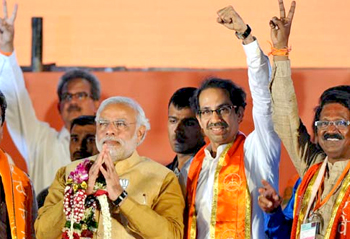 Mumbai/ New Delhi: Oct 21: A day after election results were announced, a reunion of the Bharatiya Janata Party (BJP) and the Shiv Sena appeared possible with the regional party publicly expressing its willingness to join the government without any conditions.
Mumbai/ New Delhi: Oct 21: A day after election results were announced, a reunion of the Bharatiya Janata Party (BJP) and the Shiv Sena appeared possible with the regional party publicly expressing its willingness to join the government without any conditions.
The BJP also sought to know from Transport Minister Nitin Gadkari, a senior Maharashtra leader, if he was interested in becoming the chief minister. Gadkari has officially denied several times in the past that he was aspiring for the top post.
Party sources, however, said he has not communicated his mind to the top leadership so far and many chief ministerial hopefuls are also pushing him to lead the state government.
Devendra Fadnavis, who like Gadkari is from Nagpur, is being considered a front-runner for the chief minister’s post, given the backing he has from Prime Minister Narendra Modi.
BJP sources said the top leadership could have tried to read the Rashtriya Swayamsevak Sangh’s mind on government formation by reaching out to Gadkari, who is very close to its chief Mohan Bhagwat. BJP chief Amit Shah met Gadkari at his residence on Monday to consult him on progress made in the government formation.
The discussion on government formation in both states also figured in the dinner hosted by the prime minister for his council of ministers at 7 Race Course Road.
BJP observers, Home Minister Rajnath Singh and general-secretary J P Nadda, will fly to Mumbai on Tuesday afternoon to hold a meeting with newly elected party MLAs to ascertain their view on who should be their leader.
The BJP, along with its four allies, won 122 seats but fell short of 23 MLAs from reaching a majority. Though the Nationalist Congress Party has reiterated its offer of providing “unconditional outside support”, the BJP seems to be favouring the Sena which has 63 MLAs.
In Mumbai, Sena leader Anil Desai stated that the party was in touch with the BJP for the last 24 hours in an attempt to bury the past. “We have been talking to the BJP for the last 24 hours. The mandate is for the BJP and the Sena and the people want a stable government from the two parties,” Desai said.
Though the Sena has not received any written offer to join the government, Desai said: “We are expecting any kind of proposal from the BJP. Uddhavji has made it very clear, whatever comes our way, we will go ahead on that.”
BJP general secretaries Rajiv Pratap Rudy and Om Prakash Mathur, who were in Mumbai, met state unit president Devendra Fadnavis, opposition leaders Eknath Khadse and Vinod Tawde ahead of initiating detailed discussions.
In the 288-member Maharashtra Assembly, the BJP is at the top with 122 seats and needs the support of 23 MLAs to form the government.





Comments
Add new comment